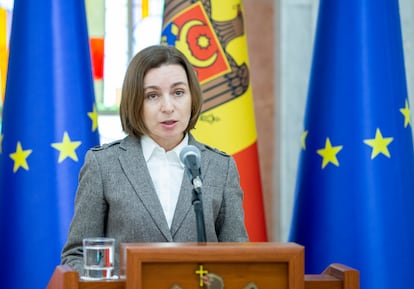Transnistria, a powder keg anchored in the Soviet era
Unrest in this separatist region of Moldova, which lies on the border with Ukraine and contains a large weapons arsenal, could amplify instability in Europe

Tension is running high in the ex-Soviet enclave of Transnistria, an unrecognized breakaway region of Moldova with a pro-Russian majority. Embedded between a narrow strip along the Dniester River and Ukraine, it officially calls itself the Pridnestrovian Moldavian Republic, and its independence has not been recognized by the United Nations or even by Russia itself.
This Cold War powder keg is now close to imploding due to the war in the neighboring country, after hibernating for more than 30 years. The explosions on Tuesday in a building of the Security Ministry, in a military unit near Parcani and in the radio and television towers in Grigoriopol, as well as in the airfield of the capital Tiraspol, have caused a sudden escalation of insecurity in Transnistria.
This small territory of 1,607 square miles (4,163 square kilometers) officially has half a million inhabitants, although it is estimated that only about 200,000 people currently reside there, since a large majority have emigrated to Russia and other surrounding countries. In Transnistria, residents live under a barrage of Russian propaganda. Moldovan television broadcasts and radio waves seem to hit a wall on the invisible dividing line of the Dniester without being able to penetrate beyond.
“Transnistrians believe that there is no war and that Vladimir Putin will save them from potential invaders of their territory,” says Vera, a pensioner who was born in a locality just under seven kilometers from Tiraspol. “Moscow has bribed retirees; for decades, they have been receiving $20 more in their pensions than Moldovan retirees.” There are some young people left in the capital due to the job opportunities, while the rest of the region is depopulated with few hospitals and few schools.
Transnistria keeps intact its past linked to the Soviet empire. It has a government, its own flag, the hammer and sickle appear on its shield, and it has its own armed forces. The main avenue of the capital is called October 25, the date of the Bolshevik revolution. And you can only pay in Transnistrian rubles.
The Sheriff conglomerate of companies (gas stations, supermarkets, telecommunications, energy, alcohol and steel, as well as the soccer club) supports the political and economic life of this rebel enclave that declared itself de facto independent in 1990 to avoid a possible unification of Moldova with Romania.
In recent years, the oligarchs who own the Sheriff group have increased their trade relations with Moldova, Ukraine and the European Union as a sign of stabilization. They even advocate for peace: Sheriff Tiraspol soccer players surprised the world in mid-March by posing with a banner with the slogan “Stop War” before a match in the Moldovan league.
The main source of income in Transnistria is due to the negligible price paid to Gazprom for Russian gas. According to an investigation by the website anticorruptie.md, the metallurgical plant in the Transnistrian municipality of Rabnita, located about 120 kilometers from Tiraspol, near the Ukrainian border, accounted for almost half of the budget of the separatist authorities. Their profits come from the low cost of production due to the minuscule price they pay for gas, plus they do not pay taxes to the Moldovan authorities, a tax exemption that the Moldovan government grants in order to remove any additional tension, according to analysts.
Military backing from Moscow
Since 1992, when the war against Moldova broke out, causing more than 1,000 deaths in the four months that it lasted, Transnistria has survived as an independent republic thanks to economic, but also military, support from Moscow. Russia maintains 500 soldiers deployed in the different checkpoints as peacekeepers and another 1,500 belonging to the Operational Group of Russian Troops (GOTR), heir to the XIV Soviet Army. This special regiment landed in this enclave during the collapse of the USSR with the mission of guaranteeing the security of an arsenal of more than 40,000 tons of weapons and ammunition (including howitzers and mines), which were stored inside a warehouse in the small town of Cobasna.
Only half of the arsenal remains, as the rest was destroyed or removed between 2000 and 2004 due to deteriorating relations between the Transnistrian authorities and those in the Moldovan capital, Chisinau. “If there was an explosion it would be devastating for both Ukraine and Moldova. That detonation could be equivalent to the Hiroshima atomic bomb,” says Ion Leahu, a former member of the Unified Control Commission, a body in charge of the security zone in the Dniester.
The president of Moldova, Maia Sandu, has demanded that the Russian troops be replaced by a group of observers from the Organization for Security and Co-operation in Europe (OSCE), a request that Russia rejects, while the Transnistrian authorities allege reasons of security while the conflict remains unresolved.

“The XIV Army (current GOTR) is preparing to fight. Their soldiers are digging trenches and they only have permits of two hours a week to see their families,” a source close to a member of this detachment told EL PAÍS. “They have orders to be ready at any moment for war and they have old ammunition, but a lot of it. They even have a large underground airport”, the same source claimed.
Tiraspol has an army of around 10,000 soldiers, to which must be added some 15,000 reservists – compared to 7,000 Moldovan soldiers – and it has at least 18 relatively modern T-55 and T-72 tanks.
To calm the waters, Transnistrian leader Vadim Krasnoselsky announced on Tuesday that the traditional May 9 parade, in honor of the victory over Nazi Germany 77 years ago, is being canceled on the grounds that the security of crowds cannot be guaranteed in light of the recent explosions.
Tu suscripción se está usando en otro dispositivo
¿Quieres añadir otro usuario a tu suscripción?
Si continúas leyendo en este dispositivo, no se podrá leer en el otro.
FlechaTu suscripción se está usando en otro dispositivo y solo puedes acceder a EL PAÍS desde un dispositivo a la vez.
Si quieres compartir tu cuenta, cambia tu suscripción a la modalidad Premium, así podrás añadir otro usuario. Cada uno accederá con su propia cuenta de email, lo que os permitirá personalizar vuestra experiencia en EL PAÍS.
¿Tienes una suscripción de empresa? Accede aquí para contratar más cuentas.
En el caso de no saber quién está usando tu cuenta, te recomendamos cambiar tu contraseña aquí.
Si decides continuar compartiendo tu cuenta, este mensaje se mostrará en tu dispositivo y en el de la otra persona que está usando tu cuenta de forma indefinida, afectando a tu experiencia de lectura. Puedes consultar aquí los términos y condiciones de la suscripción digital.
More information
Últimas noticias
Welcome to the post-religion era: The idea of Christianity as the absolute truth has become obsolete
‘I thought you would like it’: The risky sexual practice popularized by TV shows and TikTok
The digitalization of tourism: ‘They promise experiences and gave us the worst possible one’
Mexican peso defies uncertainty with forecasts of a new period of stability in 2026
Most viewed
- Sinaloa Cartel war is taking its toll on Los Chapitos
- Reinhard Genzel, Nobel laureate in physics: ‘One-minute videos will never give you the truth’
- Oona Chaplin: ‘I told James Cameron that I was living in a treehouse and starting a permaculture project with a friend’
- Why the price of coffee has skyrocketed: from Brazilian plantations to specialty coffee houses
- Silver prices are going crazy: This is what’s fueling the rally









































